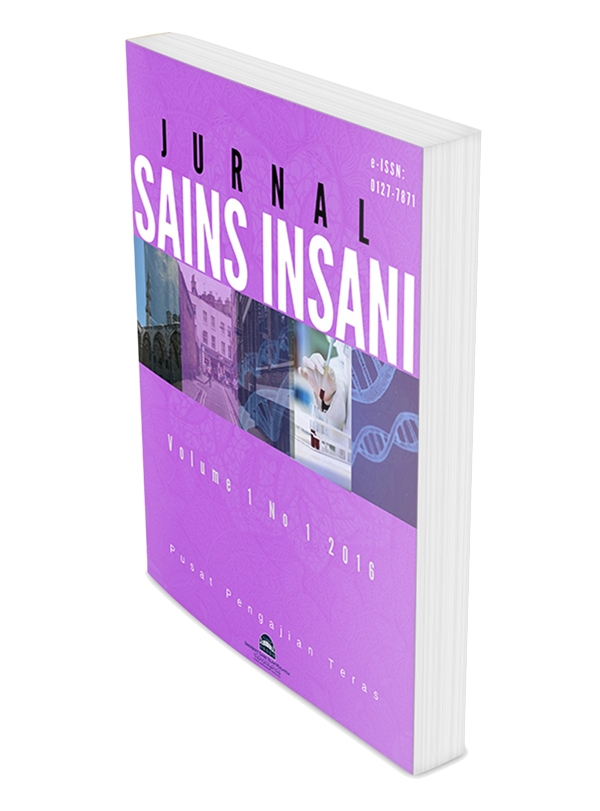The Concept of Daulat and Its Impact on Concubines (Gundik) in the Malacca Sultanate
Konsep Daulat dan Kesannya Terhadap Gundik di Kesultanan Melayu Melaka
DOI:
https://doi.org/10.33102/sainsinsani.vol10no1.746Keywords:
Daulat, Gundik, concubines, Political, Malacca SultanateAbstract
Abstract: This study intends to demonstrate how the daulat concept in the past permeates society through including the gundik in the Malacca Sultanate in determining their actions and behaviour behind the palace walls. In addition, this paper aims to describe the historical realities facing the gundik by reflecting on the significant account stated in Sulalatus Salatin. The analysis was conducted as library research, where the analysis derived from Malay magnum opus, Sulalatus Sulatin, is heavily studied. The findings that strong Malay adat, which is daulat of the sultan, is part and parcel, limit the movement of gundik to explore further their social and political roles. Furthermore, the Malays in the past tended to lead their social lives solely to adat and religious perceptions molded by traditional views where women’s circulation was restricted than getting involved in social and political activities. Interestingly, most of the Sultan’s gundik derived from the Bendahara lineage, where the most consistent people to uphold justice and honour the daulat is from Bendahara. Thus, it can be assumed that daulat, along with narrow-minded worldview, give away hints as to why the treatment of gundik was poor and their role was limited only behind the palace wall.
Keywords: Daulat, Gundik, Concubines, Political, Malacca Sultanate
Abstrak: Artikel ini bertujuan untuk menunjukkan bagaimana konsep daulat berakar umbi di dalam masyarakat Melayu dalam membentuk tingkah laku masyarakat, khususnya melalui peranan dan layanan terhadap gundik dalam Kesultanan Melaka. Kajian ini meneliti bagaimana daulat mempengaruhi tindakan serta tingkah laku individu di sebalik tembok istana. Selain itu, makalah ini turut mengupas realiti sejarah yang dihadapi oleh golongan gundik berdasarkan catatan penting dalam karya agung Melayu, Sulalatus Salatin. Kajian ini menggunakan kaedah penyelidikan kepustakaan dengan analisis teks yang mendalam terhadap Sulalatus Salatin. Dapatan kajian menunjukkan bahawa kepatuhan yang kuat terhadap adat dan kesucian konsep daulat Sultan telah mengehadkan keupayaan gundik untuk terlibat secara aktif dalam ruang sosial dan politik. Masyarakat Melayu yang berakar umbi dalam pandangan tradisional serta keagamaan telah menetapkan batasan yang ketat terhadap pergerakan wanita, lalu menghadkan peranan mereka kepada ruang domestik dan peribadi. Menariknya, kebanyakan gundik Sultan berasal daripada keturunan Bendahara—iaitu golongan yang kuat dalam menegakkan keadilan dan menghormati daulat Sultan. Hubungan ini memperlihatkan bahawa konsep daulat, yang digabungkan dengan pandangan dunia yang konservatif, telah menyumbang kepada peminggiran golongan gundik, sekali gus menghadkan peranan mereka kepada lingkungan istana dan menafikan penglibatan mereka dalam ranah sosial dan politik yang lebih luas.
Kata kunci: Daulat, Gundik, Gundik Diraja, Sosio Politik, Kesultanan Melaka
Downloads
References
Ariffin Omar. (2015). Bangsa Melayu: Konsep Bangsa Melayu dan Demokrasi dan Komuniti 1945-1950. Petaling Jaya: SIRD
Azmi Ariffin. (2012). Syed Hussein Alatas: Pemikiran Kolonial dan Gagasan Feudalisme Melayu. Akademika, Vol 82 (1), 21-30https://journalarticle.ukm.my/5351/1/Akademika82(1)%2520Bab%25203-L.pdf
Byungkuk Soh. (2002). The Invention of Tradition: The Royal Power of Contemporary Malaysia in A Historical Perspective. Korean Association of Southeast Asian Studies, 12, 2, 169-206https://www.sabrizain.org/malaya/library/royalpower.pdf
Clarence-Smith, W. G. (2007). Eunuchs and Concubines in the History of Islamic Southeast Asia. Manusya: Journal of Humanities, 10(4), 8- 19. https://doi.org/10.1163/26659077-01004001
Ismail Azman. (2009). Perkahwinan dan Kekeluargaan Raja-Raja Melayu dalam Sejarah Melayu. Shah Alam: Karisma Publication
Kheng, C. B. (1993). Power Behind the Throne: The Role of Queens and Court Ladies in Malay History. Journal of the Malaysian Branch of the Royal Asiatic Society, Vol 66, No. 1 (264), 1–21. https://www.jstor.org/stable/41486187
Mahani Musa. (2017). Aristocratic Women in Political and Economic Spheres in Malaya Before 1941. The European Proceedings of Social & Behavioural Sciences, 419-427https://doi.org/10.15405/epsbs.2019.09.47
Mahani Musa. (2017). Kaum Wanita di Zaman Kesultanan Melayu Melaka: Antara Batasan Tradisi dan Realiti. SEJARAH Journal of the Department of History 6,6, 8-34https://doi.org/10.22452/sejarah.vol6no6.1
Milner. A. (2016). Kerajaan: Budaya Politik Melayu Di Ambang Pemerintahan Kolonial. Petaling Jaya: SIRD.
Mohammad Yusoff Hashim. (2017). Daulat Dalam Tradisi Budaya dan Politik Kesultanan Melayu Abad ke-15 dan Awal Abad ke-16: Antara Mitos dan Realiti. SEJARAH, Vol 3 No 3, 215-238https://doi.org/10.22452/sejarah.vol3no3.10
Muhammad Yusof Hashim. (1992). The Malay Sultanate of Melaka: A Study of Various Aspects of Malacca in the 15th and 16th Centuries in Malaysian History. Kuala Lumpur: Dewan Bahasa dan Pustaka
Muhammad Yusof Hashim. (2015). Kesultanan Melayu Melaka Edisi Kedua. Kuala Lumpur: Dewan Bahasa dan Pustaka
Muhammad Yusof Ibrahim. (1998). Kesultanan Melayu Melaka : Pensejarahan dan Kesejarahan. Kuala Lumpur: Persatuan Sejarah Malaysia
Ruzy Suliza Hashim. (2003). Out of Shadow: Women in Malay Court Narratives. Bangi: Universiti Kebangsaan Malaysia
Syed Hussein Alatas. (1968). Feudalism in Malaysian Society: A Study in Historical Continuity. Civilizations, Vol 18, No 4, 579-592 https://lestarihikmah.com/wp-content/uploads/2022/08/alatas1968Feudalism-in-Malaysian-society.pdf
Wan Razali, W., & Abdul Rahman, M. (2019). The Power of the Concubine in Selected Traditional Malay Historiographical Literary Works. Malay Literature, 32(1), 1-15. https://doi.org/10.37052/ml.32(1)no1
Downloads
Published
How to Cite
Issue
Section
License
Copyright (c) 2025 Nor Farhain Zaharani (Author)

This work is licensed under a Creative Commons Attribution 4.0 International License.
1. Author holds the copyright of the article.
2. Jurnal Sains Insani owns the rights to publish the article. The writer may request permission to republish the article from the editor.
3. Jurnal Sains Insani follows the APA (American Psychological Association) style for all in-text citation and list of bibliographies.











